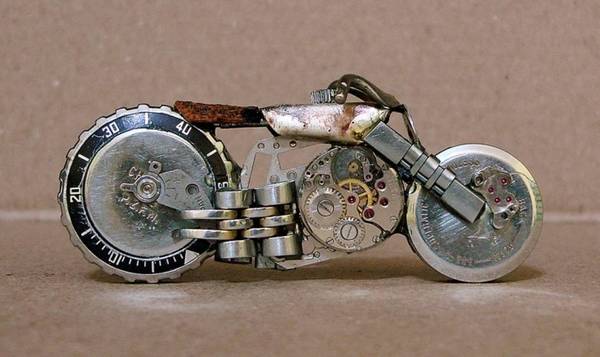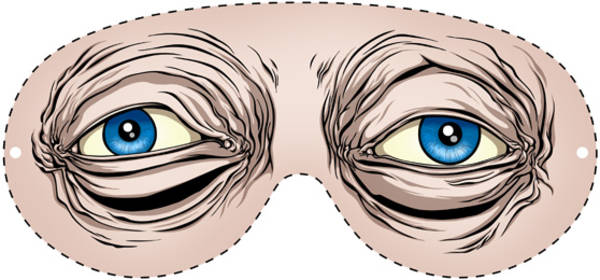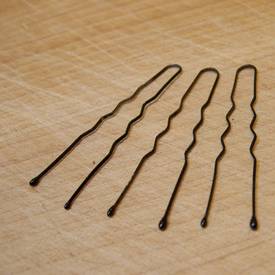The Latest from Boing Boing |  |
- Is sugar a poison?
- Ethiopia's "newspaper landlords" rent the want-ads by the minute
- More watch-part motorcycles
- Backwards Beekeepers on CNN
- NYT: Is Sitting a Lethal Activity?
- Variety loses legal round in battle with punk band Vandals over album cover
- Christian protesters destroy controversial Andres Serrano art "Piss Christ"
- LA Library, 1960: Gun-toting child reads bunny book
- Public Knowledge announces "Copyright School" video challenge
- Twitters: Robin Cooper phone pranks Apple store
- Standing desk prototype #1
- The Fifth Question: Why Manischewitz?
- Xeni on The Madeleine Brand radio show: Russia's "Gaga-esque Gagarin Glitzothon" (audio)
- China's "Jasmine Revolution": anonymous out-of-country bloggers troll the politburo
- Mild brain shocks may improve learning and cognition
- Chocolate compound beats codeine for cough-suppression
- It's people like us what makes trouble: the pernicious influence of immigrants in the UK.
- Depressed man eats own finger
- Steve Buscemi's Eyes: the printable mask
- The first underwater color photo
- NAS studying cancer risk among people who live near nuclear facilities
- A race to document the mysterious history of 1000 English words
- Famed Egyptologist sentenced in corruption case
- A failure leads to new questions in HIV drug trial
- AT&T future of telcoms video 1962, directed by Jetsons writer
- Pit cherries and olives with a hairpin
- Ticklish penguin
- Biopunk in an age without wonder
- Motorcycles made from watch parts
- Privacy, Facebook, politics and kids
| Posted: 18 Apr 2011 10:50 PM PDT Gary "Big Fat Lie" Taubes wrote a long feature for the NYT Magazine analyzing the claims made by UCSF childhood obesity expert Robert H. Lustig in his infamous lecture Sugar: The Bitter Truth , which has gotten about a million YouTube views (it's also had other exposure: I watched it last year on UC cable access while in LA). Lustig claims that sugar is a "chronic toxin" -- a poison that will make you sick if you eat it for long enough -- and he blames it for everything from cancer to heart disease. Taubes traces the history of this theory about sugar through the past century, and concludes that while not conclusive, the evidence is worrying. I've tried to eliminate sugar from my diet with varying success since 2003, when I did a year of "strict Atkins" and lost 80 lbs, most of which I've kept off since by avoiding processed carbs where possible. I find that eating a little sugar (or high-carb food like bread) generally leads to cravings for a lot more, which means that slight slips tend to snowball. Lustig's argument, however, is not about the consumption of empty calories -- and biochemists have made the same case previously, though not so publicly. It is that sugar has unique characteristics, specifically in the way the human body metabolizes the fructose in it, that may make it singularly harmful, at least if consumed in sufficient quantities.Is Sugar Toxic? (via /.) |
| Ethiopia's "newspaper landlords" rent the want-ads by the minute Posted: 19 Apr 2011 04:09 AM PDT Ethiopia's "newspaper landlords" are entrepreneurs who rent the right to read a US$0.35 newspaper for 20-30 minutes at a go, for less than $0.01 per rental. Most of their customers are reading the want-ads. Newspaper publishers are ambivalent about the practice -- on the one hand, it creates a newspaper-reading habit among the nation's aspiring poor, but on the other hand, rentals displace some sales -- and the "landlords" complain that customers steal their newspapers. Tesfaye says that 30 to 40 people will read a single paper. At the end of the day, the well-thumbed publications can be sold on.Renting a read from 'newspaper landlords' |
| Posted: 18 Apr 2011 10:41 PM PDT  If you enjoyed yesterday's post about Dkart71's motorcycles made from watch parts, you're sure to enjoy Brazilian artist Blancosur's similar pieces. Motos feitas de peças de relógios/Small motorcycles-watch parts |
| Posted: 18 Apr 2011 04:43 PM PDT [Video Link] It was a lot of fun to see my friends from the Backward Beekeepers club in Los Angeles in this CNN report. I wrote about the Backwards Beekeepers in my book Made by Hand, which is selling on Amazon in the United States for the bargain price of $10.38, hardcover. |
| NYT: Is Sitting a Lethal Activity? Posted: 18 Apr 2011 03:58 PM PDT I had been planning on making a standing desk for some time now, but the thing that really got me off my butt was this article in the New York Times magazine by James Vlahos, titled "Is Sitting a Lethal Activity?" People don't need the experts to tell them that sitting around too much could give them a sore back or a spare tire. The conventional wisdom, though, is that if you watch your diet and get aerobic exercise at least a few times a week, you'll effectively offset your sedentary time. A growing body of inactivity research, however, suggests that this advice makes scarcely more sense than the notion that you could counter a pack-a-day smoking habit by jogging. "Exercise is not a perfect antidote for sitting," says Marc Hamilton, an inactivity researcher at the Pennington Biomedical Research Center.Is Sitting a Lethal Activity? |
| Variety loses legal round in battle with punk band Vandals over album cover Posted: 18 Apr 2011 03:12 PM PDT The Los Angeles-based punk band the Vandals would appear to have won an important round in a legal battle with the entertainment publication Variety, over a dispute involving Variety's logo and a Vandals album cover. The story is as full of LOL as it is of legalese, and involves a few YouTubed mockery videos made by the band and their attorney. |
| Christian protesters destroy controversial Andres Serrano art "Piss Christ" Posted: 18 Apr 2011 04:11 PM PDT  "Piss Christ," a long-controversial work created in 1987 by NYC-based artist Andres Serrano, was attacked with hammers and destroyed yesterday (Palm Sunday) following an "anti-blasphemy" campaign by French Catholic fundamentalists in the southern city of Avignon. The violent slashing of the picture, and another Serrano photograph of a meditating nun, has plunged secular France into soul-searching about Christian fundamentalism and Nicolas Sarkozy's use of religious populism in his bid for re-election next year.More in the Guardian (via LGF). Image: Wikipedia |
| LA Library, 1960: Gun-toting child reads bunny book Posted: 18 Apr 2011 02:47 PM PDT  Wrapped in Thought: Four-year-old Philip Ross finds ABC Easter Bunny more interesting than his guns and spurs. Son of Mr. and Mrs. Max Ross, 12605 Califa St., North Hollywood, he said he can't read but 'didn't mind looking at pictures.' Librarians at North Hollywood branch library said he is a frequent visitor."Contributed to the Boing Boing Flickr Pool by Bart King. Captions invited. Also, wonder where this child (who'd now be an adult) is today! |
| Public Knowledge announces "Copyright School" video challenge Posted: 18 Apr 2011 02:20 PM PDT Mehan J. tells Boing Boing, We at Public Knowledge were pretty upset when we saw YouTube's "Copyright School" educational video, which discourages remixing, dismisses fair use as overly complex and effectively tells users that only "original" content is suitable for upload. So we're challenging YouTube users to produce a better "Copyright School" video, one that explains both what you can and can't do with copyrighted content without permission from the rightsholder. The creator of the best video will win $1000! |
| Twitters: Robin Cooper phone pranks Apple store Posted: 18 Apr 2011 02:12 PM PDT |
| Posted: 18 Apr 2011 03:56 PM PDT  I built an elevated platform so I could try working at a standing desk. It's 11.5 inches high, and I built it from .75" x .75" sticks and .5" plywood. I added lots of triangular bracing and then sat on it to make sure it could hold my 27" iMac without collapsing. I just started using it this morning so I can't say how much I like it yet. I'm standing on a gardener's kneeling pad, which is probably too spongy. I might switch to a yoga mat.
This is a prototype. I am going to use this one for a week, take notes, and make another prototype. (First note for Prototype 2 - a nook under the plywood to hold the external drives and USB hub.) Here's Donald Rumsfeld at his most charming (which is about as charming as a monitor lizard) defending his standing desk and explaining to the CNN host that Thomas Jefferson had one and that naval officers use them. Go Rummy! UPDATE: Here is the image I'm using on my desktop. |
| The Fifth Question: Why Manischewitz? Posted: 18 Apr 2011 12:38 PM PDT My father wasn't a drinker. In fact, I never saw him imbibe at all, except of course for a few sips of Manischewitz at Passover. In memory of my dad on this first night of Passover, I link to cultural historian Yoni Appelbaum's essay at The Atlantic titled "The 11th Plague? Why People Drink Sweet Wine on Passover." From The Atlantic: "The 11th Plague? Why People Drink Sweet Wine on Passover" (Thanks, Bob Pescovitz!) |
| Xeni on The Madeleine Brand radio show: Russia's "Gaga-esque Gagarin Glitzothon" (audio) Posted: 18 Apr 2011 01:02 PM PDT 
I joined Madeleine Brand Show guest-host Alex Cohen today for a radio segment on my recent trip to Moscow with Miles O'Brien and his documentary crew, on the occasion of the 50 year anniversary of Yuri Gagarin's first space flight. On April 12, 1961, aboard the Vostok 3KA-3, Gagarin became the first human ever to venture into space. On the show today, we talked about the crazy Cosmonaut's Day celebration we attended inside the Kremlin; what space tourists do in space; why NASA has bought up seats on the Soyuz as our shuttle program ends, and we also chatted about weird Russian strawberry sushi and the amazing Soviet time capsule that is the Moscow metro. [Listen here, or download MP3 here].
Miles shot video of the military choir finale, with breakdancing cosmonaut cosplay kids. That video is embedded above, or here on YouTube. The good stuff starts around 1:39 in. And below, a translated video of Russian President Medvedev's speech at the Kremlin event. His speech begins around 2:00 into the video. Of note: under his administration, Russia has increased space spending, and is building a new cosmodrome in Russia (so they won't have to lease space at the Baikonur cosmodrome in neighboring Kazakhstan). This, as the US slashes NASA's budget and ends the shuttle program.
|
| China's "Jasmine Revolution": anonymous out-of-country bloggers troll the politburo Posted: 17 Apr 2011 10:49 PM PDT Anonymous international bloggers have been writing in Chinese about a "Jasmine revolution" in China, calling on Chinese people to show their discontent for local corruption by going to places that are normally crowded and walking around, not doing anything special. The Chinese authorities freaked out and blocked these sites, and most people in China have never heard of them -- but because people keep turning up and walking around in the normally crowded places, the politburo is convinced that the Jasmine Revolution is in full swing. The organizers, whoever and wherever they are, have repeatedly called on people to gather in a range of popular and public areas in the centre of major cities across China - shopping malls and university campuses - and go for a stroll every Sunday afternoon to call for minor political change. These public areas are, at that time of day, normally filled with young people and out-of-town domestic tourists, all now potential 'protesters'. Now, because of the number of competing and overlapping security agencies, there is a lot of pressure on the local commanders to make some arrests and to show some success, but there are no genuine protesters, just some bemused local tourists and a lot of foreign journalists. So some young tourists get beaten up and taken away, and some journalists get smacked around. This then acquires a predictable, and well understood, dynamic of its own. At the same time, the organisers have used a wide range of popular and politically 'safe' words to use as code words - the characters for 'Two Conferences' being one, which is also the political conference that occurred in Beijing at the same time. Last weekend it was the 'Three Represents', which was Jiang Zemin's political thought legacy, and so on. These keywords get picked up by the censors, and all web and SMS traffic using them gets shut down or blocked - Jasmine itself is of course popular in Chinese culture and widely used in branding, but sites using 'Jasmine' in their copy, however innocuous, are blocked - with real-world social, political and economic consequences.THE "JASMINE REVOLUTION" (via Warren Ellis) |
| Mild brain shocks may improve learning and cognition Posted: 18 Apr 2011 10:36 AM PDT Last year a succession of volunteers sat down in a research lab in Albuquerque, New Mexico to play DARWARS Ambush!, a video game designed to train US soldiers bound for Iraq. Each person surveyed virtual landscapes strewn with dilapidated buildings and abandoned cars for signs of trouble — a shadow cast by a rooftop sniper, or an improvised explosive device behind a rubbish bin. With just seconds to react before a blast or shots rang out, most forgot about the wet sponge affixed to their right temple that was delivering a faint electric tickle. The volunteers received a few milliamps of current at most, and the simple gadget used to deliver it was powered by a 9-volt battery."Neuroscience: Brain buzz"
|
| Chocolate compound beats codeine for cough-suppression Posted: 17 Apr 2011 10:33 PM PDT A compound found in chocolate outperforms over-the-counter and codeine-based cough-suppressants in clinical trials. The compound, theobromine, was written up in the Federation of American Societies for Experimental Biology Journal following a small placebo-controlled study at Imperial College London. Our GP told us that the best thing for a cough was a spoonful of honey, and it's pretty much all we use around our house (well, that and the vile, repulsive, disgusting, incredibly effective Buckley's Mixture -- but that's a last resort). Persistent coughs melt away with chocolate (via Amanda Palmer) (Image: Chocolate, a Creative Commons Attribution (2.0) image from 26149290@N02's photostream) |
| It's people like us what makes trouble: the pernicious influence of immigrants in the UK. Posted: 18 Apr 2011 10:02 AM PDT Feorag NicBhride's "The pernicious influence of immigrants in the UK" is a non-exhaustive catalog of the many awful travesties wrought by we dirty foreign immigrants on the pure, clean shores of Britain, including tea, the Conservative party, football, and the English language. As Charlie Stross says, "if you're one of that 40% [of British residents polled who do not think the UK has benefited in any way from immigration].you can stop reading my books right now, because obviously they are of no benefit to you." * The English language (the Anglo-Saxons, much modified by the Normans)The pernicious influence of immigrants in the UK |
| Posted: 18 Apr 2011 09:53 AM PDT A severely-depressed fellow in New Zealand severed his own finger, cooked it up with some vegetables, and ate it. Apparently this is only one of eight known cases of "self-cannibalism." The incident was discussed in the scientific journal Australasian Psychiatry. From their report, quoted in the New Zealand Herald: "At the end of 2008, following another personal crisis, and while not being fully compliant with his medication, he spiralled into another episode of depression. He experienced significant insomnia and suicidal ideation, and ruminated for days about cutting off his fingers."Depressed man cooks and eats his finger" |
| Steve Buscemi's Eyes: the printable mask Posted: 17 Apr 2011 10:37 PM PDT  From the collective unconscious that gave us the "Chicks with Steve Buscemi's eyes" meme, a print-and-wear Steve Buscemi's Eyes mask. Alex Pardee: The Free At-Home Version Of STEVE BUSCEMI'S EYES! (via Super Punch) |
| The first underwater color photo Posted: 18 Apr 2011 09:06 AM PDT  National Geographic has a slideshow that shows off major milestones in underwater photography. This image is the first color photo ever taken underwater.
|
| NAS studying cancer risk among people who live near nuclear facilities Posted: 18 Apr 2011 09:03 AM PDT Since September 2010, the United States National Academy of Sciences has been working on a comprehensive study of cancer risk in people living near U.S. Nuclear Regulatory Commission-licensed nuclear facilities. A committee meeting for this study is scheduled for today. You can watch a live webcast, or, if you live in Chicago, attend some of the sessions that are open to the public. |
| A race to document the mysterious history of 1000 English words Posted: 18 Apr 2011 08:44 AM PDT  At the University of Minnesota, a linguistics professor is racing against his own mortality to finish a dictionary that will explain the origins and history of some of the most mysterious words in the English language. If he completes it, it will be the second time any language has had its linguistic history documented in this way. The trouble is, Anatoly Liberman is 74, and he thinks he needs at least another decade to finish his dictionary.
The Minneapolis Star-Tribune: Getting In the Last Word Image: Some rights reserved by Muffet |
| Famed Egyptologist sentenced in corruption case Posted: 18 Apr 2011 08:29 AM PDT  Zahi Hawass has long been a controversial figure. This well-known Egyptologist has been frequently called to task for showboating his science, but he's also generally popular in his native Egypt because of the attention he's brought to Egyptian history and culture. He served as Minister of Antiquities under former president Hosni Mubarak, and was appointed to the same position after Mubarak was ousted. Now, Zahi Hawass might be going to jail. On Sunday, an Egyptian court sentenced Hawass to a year in jail and a fine equivalent to $1600. The Al Jazeera article linked above doesn't do a very good job of explaining what Hawass had done to end up on the wrong side of the law. Luckily, the Talking Pyramids blog has the full story, and documentation. Their account makes the sentence sound like a pretty reasonably justified case of corruption.
|
| A failure leads to new questions in HIV drug trial Posted: 18 Apr 2011 08:09 AM PDT In Africa, a human trial of drug aimed at preventing HIV infection has been halted, because women taking the drug didn't seem to be any more protected against HIV than women taking a placebo. That's happened before with trials of preventative HIV medication. What makes this situation particularly intriguing: These null results seems to be confined to women. When the drug was previously tested in gay and bisexual men, it reduced their chances of being infected with HIV by between 44% and 73%, depending on how faithfully the men stuck to the drug regimen. |
| AT&T future of telcoms video 1962, directed by Jetsons writer Posted: 18 Apr 2011 10:57 PM PDT Paleofuture features a smashing AT&T industrial video called "Talking of Tomorrow," about the future of telecommunications, directed by Chuck Couch, who wrote The Jetsons. As Paleo notes, the animation style is reminiscent of Jay Ward's Rocky and Bullwinkle, and features a teleworking engineering exec whose videoconferencing takes place from a soundproof room attached to his house: "Business, school and play in this retrofuturistic utopia all depend on the highly advanced communications technologies brought to you by Bell Telephone Labs. Documents -- or "business materials" as they call them -- are exchanged by 'telephonic machines.' Lasers transmit phone calls and TV shows from space. Data processing machines... um... process data." |
| Pit cherries and olives with a hairpin Posted: 17 Apr 2011 10:40 PM PDT Hanne Blank's 2010 collection of tips for using everyday household objects instead of expensive kitchen gadgets is full of great advice, like using bent hairpins to pit olives and cherries. The Things That Earn Their Keep (via Lifehacker) |
| Posted: 18 Apr 2011 04:07 PM PDT |
| Biopunk in an age without wonder Posted: 12 Apr 2011 06:20 PM PDT Marcus Wohlsen has covered startup culture, the maker scene, and the marijuana industry as a reporter in the San Francisco bureau of The Associated Press. His first book, Biopunk: DIY Scientists Hack the Software of Life, was published this week by Current. I asked him to contribute a few pieces about the biotech underground to run on Boing Boing. Here's the third one. (Read the first one. Read the second one.)
Buy Biopunk: DIY Scientists Hack the Software of Life on Amazon |
| Motorcycles made from watch parts Posted: 17 Apr 2011 10:44 PM PDT  DeviantArt's Dkart71 makes beautiful, detailed motorcycles out of watch parts. Motorcycles out of watch parts (via Neatorama) |
| Privacy, Facebook, politics and kids Posted: 18 Apr 2011 05:59 AM PDT The Guardian's Comment is Free video team recorded an interview with me after the TEDxObserver event. They're editing it into a series of quick pieces; the first one, about kids, privacy, and social networks, just went live. I really like the way they put it together! The most powerful mechanism we have for securing the privacy of individuals is for them to care about that privacy |
| You are subscribed to email updates from Boing Boing To stop receiving these emails, you may unsubscribe now. | Email delivery powered by Google |
| Google Inc., 20 West Kinzie, Chicago IL USA 60610 | |



 "A seder without sweet Manischewitz," the comedian Jackie Mason once said, "would be like horseradish without tears, like a cantor without a voice, like a shul without a complaint, like a yenta without a big mouth, like Passover without Jews." To the uninitiated, Passover wine is an ethnic curiosity, or a culinary ordeal on a par with lutefisk. Those who grew up drinking it, though, find in Concord grape wine the taste of Jewish tradition. And that's ironic, because there may be no more thoroughly American beverage.
"A seder without sweet Manischewitz," the comedian Jackie Mason once said, "would be like horseradish without tears, like a cantor without a voice, like a shul without a complaint, like a yenta without a big mouth, like Passover without Jews." To the uninitiated, Passover wine is an ethnic curiosity, or a culinary ordeal on a par with lutefisk. Those who grew up drinking it, though, find in Concord grape wine the taste of Jewish tradition. And that's ironic, because there may be no more thoroughly American beverage.  The researchers believe theobromine acts on the sensory nerve endings of the vagus nerve, which runs through the airways in the lungs to the brain. Capsaicin stimulates these endings to provoke coughing.
The researchers believe theobromine acts on the sensory nerve endings of the vagus nerve, which runs through the airways in the lungs to the brain. Capsaicin stimulates these endings to provoke coughing.  The kitchen gadgets I use most often tend to be things that I don't think other people even think of as "gadgets." They're not even very gadget-y. They're just things that make good kitchen tools, and perform very very well in the roles in which I use them. They're mostly little, unglamorous, and inexpensive, and while I inherited one of them, I have never received anything in this line as a gift and probably never will. Why not? Well, a dollar box of wire hairpins does not exactly make a splash as a hostess gift.
The kitchen gadgets I use most often tend to be things that I don't think other people even think of as "gadgets." They're not even very gadget-y. They're just things that make good kitchen tools, and perform very very well in the roles in which I use them. They're mostly little, unglamorous, and inexpensive, and while I inherited one of them, I have never received anything in this line as a gift and probably never will. Why not? Well, a dollar box of wire hairpins does not exactly make a splash as a hostess gift. 
Tidak ada komentar:
Posting Komentar